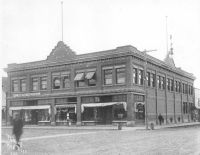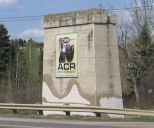|
Prosperous times for New Year's, 1912
in Red Deer
reprinted from Red Deer Express December 28, 2011
The start of a New Year is often a time for expressions of hope for
a great year to come, full of peace, prosperity and happiness. A New
Year's Eve when these wishes were particularly apt occurred 100
years ago as Red Deer entered 1912. The community was enjoying a
truly remarkable surge of growth. A heady and well-founded sense of
optimism could be found everywhere.
The great boom had been building for some time. After a brief lull
during the recession of 1908-1910, tens of thousands of new settlers
began pouring into Alberta to secure homesteads, to build new homes
and/or to establish new businesses. To use the slogan of the federal
government at the time, they were rushing in to take advantage of
'The Last Best West.'
Red Deer had been designated as a major divisional point on the
Calgary-Edmonton branch of the Canadian Pacific Railway. As such,
the town became the major staging area and distribution point for
prospective homesteaders headed for either the west country or the
fertile prairies of east Central Alberta.
A tremendous boost to the Red Deer economy came with the
construction of not one but two railroads, the Alberta Central and
the Canadian Northern Western. Both lines were headed for the rich
Brazeau coalfields at Nordegg.
The Alberta Central also had plans to build eastwards to Moose Jaw
and the Hudson Bay.
As Red Deer prospered, even more people flooded into the community.
Not surprisingly, many of the new jobs and opportunities were in the
construction industry. The statistics help to tell the story.
The value of building permits leapt from $77,005 in 1910 to $389,040
in 1912 -- an increase of more than 500%.
The local brickyards, Piper's and Red Deer, dramatically increased
their production as did Cement Builders Ltd., makers of cement tile,
shingles and inter-locking building blocks. The Great West Lumber
mill in North Red Deer cut less than two million board feet in 1909.
By 1912, the demand for fresh lumber was so strong that the mill was
cutting more than 3.5 million board feet.
As the New Year progressed, several important new businesses and
industries were established. The Freytag Tannery was built in North
Red Deer. Red Deer Holdings started a tree and flower nursery as
well as a foundry.
The Laurentia Milk Company constructed a milk processing plant on
Blowers (51) St.
This was a fitting addition to the community as Red Deer also
boasted the best milk-producing cow in the British Empire, Rosalind
of Old Basing. That Jersey Cow was so famous that the Red Deer Board
of Trade held a special banquet in her honour.
Red Deer's public services were greatly expanded.
A large addition was built onto both the Town Hall and the Memorial
Hospital. The magnificent Alberta Ladies College building was
constructed on the brow of the East Hill. St. Joseph Convent had a
large addition built on its west side.
Two new elementary schools were constructed, one in the Village of
North Red Deer and the other in the south side of the Town of Red
Deer.
Red Deer's fairgrounds were greatly expanded with new exhibits
buildings, barns and a large grandstand. All those improvements were
completed in less than two months.
The great boom resulted in a very hot real estate market. The local
assessment doubled in two years. Several people began to think of
themselves as millionaires, at least on paper. More than a dozen new
subdivisions were placed on the market by developers and real estate
promoters.
With the large increase in population, plans were made to have Red
Deer incorporated as a City. After all, if Red Deer had only 323
residents in 1901 and nearly 3,000 in 1912, many felt it was not
unreasonable that the population would reach 20,000 or 30,000 by the
early 1920s.
It seemed that the wonderful good times would never end.
|

GOOD TIMES
- Smith and Gaetz Block on the corner of Ross St. and Gaetz
Ave. 1912.
Photo
courtesy of the Red Deer and District Archives
|
|

